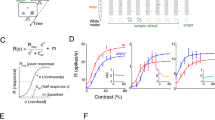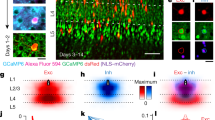Abstract
After entering the cerebral cortex, sensory information spreads through six different horizontal neuronal layers that are interconnected by vertical axonal projections. It is believed that through these projections layers can influence each other's response to sensory stimuli, but the specific role that each layer has in cortical processing is still poorly understood. Here we show that layer six in the primary visual cortex of the mouse has a crucial role in controlling the gain of visually evoked activity in neurons of the upper layers without changing their tuning to orientation. This gain modulation results from the coordinated action of layer six intracortical projections to superficial layers and deep projections to the thalamus, with a substantial role of the intracortical circuit. This study establishes layer six as a major mediator of cortical gain modulation and suggests that it could be a node through which convergent inputs from several brain areas can regulate the earliest steps of cortical visual processing.
This is a preview of subscription content, access via your institution
Access options
Subscribe to this journal
Receive 51 print issues and online access
$199.00 per year
only $3.90 per issue
Buy this article
- Purchase on Springer Link
- Instant access to full article PDF
Prices may be subject to local taxes which are calculated during checkout





Similar content being viewed by others
References
Lorente de No, R. in Physiology of the Nervous System (ed. Fulton, J.F. ) 274–301 (Oxford Univ. Press, 1943)
Douglas, R. J. & Martin, K. A. Neuronal circuits of the neocortex. Annu. Rev. Neurosci. 27, 419–451 (2004)
Lefort, S., Tomm, C., Floyd Sarria, J. C. & Petersen, C. C. The excitatory neuronal network of the C2 barrel column in mouse primary somatosensory cortex. Neuron 61, 301–316 (2009)
Thomson, A. M. & Bannister, A. P. Interlaminar connections in the neocortex. Cereb. Cortex 13, 5–14 (2003)
Callaway, E. M. Local circuits in primary visual cortex of the macaque monkey. Annu. Rev. Neurosci. 21, 47–74 (1998)
Dantzker, J. L. & Callaway, E. M. Laminar sources of synaptic input to cortical inhibitory interneurons and pyramidal neurons. Nature Neurosci. 3, 701–707 (2000)
Thomson, A. M. Neocortical layer 6, a review. Front. Neuroanat. 4, 13 (2010)
Bourassa, J. & Deschenes, M. Corticothalamic projections from the primary visual cortex in rats: a single fiber study using biocytin as an anterograde tracer. Neuroscience 66, 253–263 (1995)
Binzegger, T., Douglas, R. J. & Martin, K. A. Stereotypical bouton clustering of individual neurons in cat primary visual cortex. J. Neurosci. 27, 12242–12254 (2007)
Zhang, Z. W. & Deschenes, M. Intracortical axonal projections of lamina VI cells of the primary somatosensory cortex in the rat: a single-cell labeling study. J. Neurosci. 17, 6365–6379 (1997)
Jones, E. G. The Thalamus (Cambridge Univ. Press, 2007)
Guillery, R. W. & Sherman, S. M. Thalamic relay functions and their role in corticocortical communication: generalizations from the visual system. Neuron 33, 163–175 (2002)
Sillito, A. M. & Jones, H. E. Corticothalamic interactions in the transfer of visual information. Phil. Trans. R. Soc. Lond. B 357, 1739–1752 (2002)
Briggs, F. & Usrey, W. M. Emerging views of corticothalamic function. Curr. Opin. Neurobiol. 18, 403–407 (2008)
Cudeiro, J. & Sillito, A. M. Looking back: corticothalamic feedback and early visual processing. Trends Neurosci. 29, 298–306 (2006)
Sillito, A. M., Cudeiro, J. & Jones, H. E. Always returning: feedback and sensory processing in visual cortex and thalamus. Trends Neurosci. 29, 307–316 (2006)
Bolz, J. & Gilbert, C. D. Generation of end-inhibition in the visual cortex via interlaminar connections. Nature 320, 362–365 (1986)
Grieve, K. L. & Sillito, A. M. A re-appraisal of the role of layer VI of the visual cortex in the generation of cortical end inhibition. Exp. Brain Res. 87, 521–529 (1991)
Gong, S. et al. Targeting Cre recombinase to specific neuron populations with bacterial artificial chromosome constructs. J. Neurosci. 27, 9817–9823 (2007)
Nagel, G. et al. Channelrhodopsin-2, a directly light-gated cation-selective membrane channel. Proc. Natl Acad. Sci. USA 100, 13940–13945 (2003)
Boyden, E. S., Zhang, F., Bamberg, E., Nagel, G. & Deisseroth, K. Millisecond-timescale, genetically targeted optical control of neural activity. Nature Neurosci. 8, 1263–1268 (2005)
Niell, C. M. & Stryker, M. P. Highly selective receptive fields in mouse visual cortex. J. Neurosci. 28, 7520–7536 (2008)
Hubel, D. H. & Wiesel, T. N. Receptive fields, binocular interaction and functional architecture in the cat’s visual cortex. J. Physiol. 160, 106–154 (1962)
Chow, B. Y. et al. High-performance genetically targetable optical neural silencing by light-driven proton pumps. Nature 463, 98–102 (2010)
Gradinaru, V. et al. Molecular and cellular approaches for diversifying and extending optogenetics. Cell 141, 154–165 (2010)
Rafols, J. A. & Valverde, F. The structure of the dorsal lateral geniculate nucleus in the mouse. A Golgi and electron microscopic study. J. Comp. Neurol. 150, 303–331 (1973)
Salinas, E. & Thier, P. Gain modulation: a major computational principle of the central nervous system. Neuron 27, 15–21 (2000)
Brotchie, P. R., Andersen, R. A., Snyder, L. H. & Goodman, S. J. Head position signals used by parietal neurons to encode locations of visual stimuli. Nature 375, 232–235 (1995)
Treue, S. & Martinez Trujillo, J. C. Feature-based attention influences motion processing gain in macaque visual cortex. Nature 399, 575–579 (1999)
McAdams, C. J. & Maunsell, J. H. Effects of attention on orientation-tuning functions of single neurons in macaque cortical area V4. J. Neurosci. 19, 431–441 (1999)
Silver, R. A., Lubke, J., Sakmann, B. & Feldmeyer, D. High-probability uniquantal transmission at excitatory synapses in barrel cortex. Science 302, 1981–1984 (2003)
Adesnik, H. & Scanziani, M. Lateral competition for cortical space by layer-specific horizontal circuits. Nature 464, 1155–1160 (2010)
Markram, H. et al. Interneurons of the neocortical inhibitory system. Nature Rev. Neurosci. 5, 793–807 (2004)
Ascoli, G. A. et al. Petilla terminology: nomenclature of features of GABAergic interneurons of the cerebral cortex. Nature Rev. Neurosci. 9, 557–568 (2008)
Chance, F. S., Abbott, L. F. & Reyes, A. D. Gain modulation from background synaptic input. Neuron 35, 773–782 (2002)
Shadlen, M. N. & Newsome, W. T. The variable discharge of cortical neurons: implications for connectivity, computation, and information coding. J. Neurosci. 18, 3870–3896 (1998)
Murphy, B. K. & Miller, K. D. Multiplicative gain changes are induced by excitation or inhibition alone. J. Neurosci. 23, 10040–10051 (2003)
Andolina, I. M., Jones, H. E., Wang, W. & Sillito, A. M. Corticothalamic feedback enhances stimulus response precision in the visual system. Proc. Natl Acad. Sci. USA 104, 1685–1690 (2007)
Wang, W., Jones, H. E., Andolina, I. M., Salt, T. E. & Sillito, A. M. Functional alignment of feedback effects from visual cortex to thalamus. Nature Neurosci. 9, 1330–1336 (2006)
Wörgotter, F., Nelle, E., Li, B. & Funke, K. The influence of corticofugal feedback on the temporal structure of visual responses of cat thalamic relay cells. J. Physiol. 509, 797–815 (1998)
McClurkin, J. W. & Marrocco, R. T. Visual cortical input alters spatial tuning in monkey lateral geniculate nucleus cells. J. Physiol. 348, 135–152 (1984)
Murphy, P. C., Duckett, S. G. & Sillito, A. M. Feedback connections to the lateral geniculate nucleus and cortical response properties. Science 286, 1552–1554 (1999)
Casagrande, V. A. & Kaas, J. H. The Afferent, Iintrinsic and Efferent Connections of Primary Visual Cortex in Primates (eds Peters, A. & Rockland, P. ) (Plenum, 1994)
Grubb, M. S. & Thompson, I. D. Quantitative characterization of visual response properties in the mouse dorsal lateral geniculate nucleus. J. Neurophysiol. 90, 3594–3607 (2003)
Brainard, D. H. The psychophysics toolbox. Spat. Vis. 10, 433–436 (1997)
Fee, M. S., Mitra, P. P. & Kleinfeld, D. Automatic sorting of multiple unit neuronal signals in the presence of anisotropic and non-Gaussian variability. J. Neurosci. Methods 69, 175–188 (1996)
Kerlin, A. M., Andermann, M. L., Berezovskii, V. K. & Reid, R. C. Broadly tuned response properties of diverse inhibitory neuron subtypes in mouse visual cortex. Neuron 67, 858–871 (2010)
Ringach, D. L., Shapley, R. M. & Hawken, M. J. Orientation selectivity in macaque V1: diversity and laminar dependence. J. Neurosci. 22, 5639–5651 (2002)
Bortone, D. & Polleux, F. KCC2 expression promotes the termination of cortical interneuron migration in a voltage-sensitive calcium-dependent manner. Neuron 62, 53–71 (2009)
Bagnall, M. W., Hull, C., Bushong, E. A., Ellisman, M. H. & Scanziani, M. Multiple clusters of release sites formed by individual thalamic afferents onto cortical interneurons ensure reliable transmission. Neuron 71, 180–194 (2011)
Acknowledgements
We are grateful to M. Carandini, J. Isaacson and the members of the Scanziani and Isaacson laboratories for helpful discussions of this project, to J. Isaacson, R. Malinow and T. Komiyama for providing feedback on the manuscript, to P. Abelkop for histological help and neonatal viral injections, to J. Evora for mouse colony support and genotyping, to B. Atallah for sharing the technique for silencing the cortex by photostimulation of parvalbumin neurons and for help with the in vivo recording setup and to W. Bruns for help coding analysis software. We thank the UCSD Neuroscience Microscopy Facility (P30 NS047101) for the use of their imaging equipment. S.R.O. and H.A. were supported by postdoctoral fellowships from the Helen Hay Whitney Foundation. D.S.B was supported by a UCSD Neurobiology Training Grant (NINDS: 5T32NS007220-28). M.S. is an investigator of the Howard Hughes Medical Institute. This work was also supported National Institutes of Health grant RO1 NS069010 and by the Gatsby Charitable Foundation.
Author information
Authors and Affiliations
Contributions
H.A. performed the initial physiological characterization of the NTSR1-Cre expression system with optogenetic tools. H.A. also developed the in vivo awake recording preparation on the treadmill. S.R.O. performed all in vivo recordings. D.S.B. performed all in vitro recordings and anatomical reconstructions. S.R.O. and M.S. designed the study. M.S. wrote the paper.
Corresponding authors
Ethics declarations
Competing interests
The authors declare no competing financial interests.
Supplementary information
Supplementary Figures
This file contains Supplementary Figures 1-10 with legends. (PDF 19395 kb)
Rights and permissions
About this article
Cite this article
Olsen, S., Bortone, D., Adesnik, H. et al. Gain control by layer six in cortical circuits of vision. Nature 483, 47–52 (2012). https://doi.org/10.1038/nature10835
Received:
Accepted:
Published:
Issue Date:
DOI: https://doi.org/10.1038/nature10835
This article is cited by
-
Laminar compartmentalization of attention modulation in area V4 aligns with the demands of visual processing hierarchy in the cortex
Scientific Reports (2023)
-
Primary somatosensory cortex bidirectionally modulates sensory gain and nociceptive behavior in a layer-specific manner
Nature Communications (2023)
-
A frontal transcallosal inhibition loop mediates interhemispheric balance in visuospatial processing
Nature Communications (2023)
-
Attenuated alpha oscillation and hyperresponsiveness reveals impaired perceptual learning in migraineurs
The Journal of Headache and Pain (2022)
-
Translaminar recurrence from layer 5 suppresses superficial cortical layers
Nature Communications (2022)
Comments
By submitting a comment you agree to abide by our Terms and Community Guidelines. If you find something abusive or that does not comply with our terms or guidelines please flag it as inappropriate.



